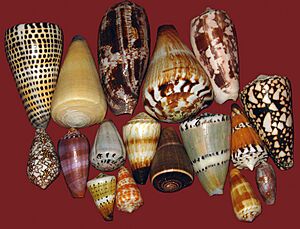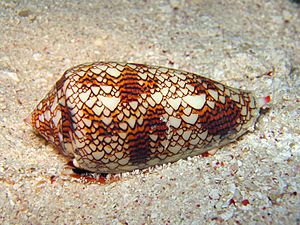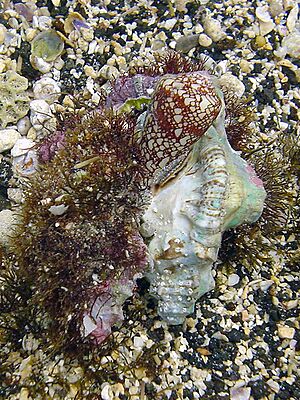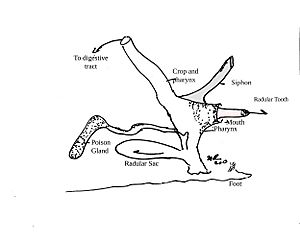Cone snail facts for kids
Quick facts for kids Cone snail |
|
|---|---|
 |
|
| A group of shells of various species of cone snails | |
| Scientific classification |
|
| Kingdom: | Animalia |
| Phylum: | Mollusca |
| Class: | Gastropoda |
| Subclass: | Caenogastropoda |
| Order: | Neogastropoda |
| Superfamily: | Conoidea |
| Family: | Conidae Fleming, 1822 |
| Subfamilies and genera | |
|
See text |
|
| Synonyms | |
|
|
Cone snails are amazing sea creatures. They are a family of sea snails called Conidae. These snails are known for their beautiful, cone-shaped shells.
But don't let their beauty fool you! Cone snails are also highly venomous. They are expert hunters in the ocean. They use a special harpoon-like tooth to catch their prey.
There are over 800 known species of cone snails. They come in many sizes, from about 1.3 cm to over 21 cm long. These snails have lived on Earth for a very long time. Scientists have found their fossils from about 55 million years ago.
Cone snails live mostly in warm, tropical waters. Their shells often have bright colors and cool patterns. The venom they produce is very powerful. It can paralyze their prey quickly.
While their sting can be dangerous to humans, their venom is also very interesting to scientists. It holds promise for creating new medicines.
Contents
Where Cone Snails Live
Tropical Ocean Homes
Cone snails live in warm, tropical, and subtropical seas around the world. You can find them in places like the Indo-Pacific region. This area is home to most cone snail species. They also live in the eastern Pacific and Atlantic oceans.
Some species have adapted to slightly cooler waters. These include areas near South Africa, the Mediterranean Sea, and southern California. They live in various ocean spots. You can find them on sand, rocks, or coral reefs. They live from shallow areas to deeper parts of the ocean.
Ancient History of Cone Snails
Fossils from Long Ago
The oldest known cone snail fossils are about 55 million years old. This means they lived during the Eocene epoch. Scientists study their DNA to understand their family tree. They found that all living cone snails belong to two main groups. These groups separated about 33 million years ago.
One group lives mostly in the eastern Pacific and western Atlantic. These areas were once connected by a waterway. The other group lives in the eastern Atlantic and Indo-Pacific. These regions were also connected by an ancient sea.
The Amazing Cone Shell
Colors and Patterns
Cone snails are famous for their beautiful shells. Their shells come in many colors and patterns. This variety makes them very popular with collectors. However, it also makes it tricky for scientists to identify each species.
Their shells are shaped like an inverted cone. The top part, called the spire, is flatter. The opening of the shell is long and narrow. A tiny, sharp lid, called an operculum, covers the opening.
Some large cone snails can grow up to 23 cm long. Many shells are brightly colored. Sometimes, a thin, clear layer called a periostracum covers the shell. This layer can hide the patterns underneath.
How Cone Snails Hunt
Clever Predators of the Sea
Cone snails are skilled hunters. They are carnivorous, meaning they eat other animals. Their diet includes marine worms, small fish, other molluscs, and even other cone snails. Since they move slowly, they need a special way to catch faster prey.
They use a unique hunting tool: a modified tooth and a venom gland. This tooth acts like a tiny, venomous harpoon. It helps them catch and paralyze their prey.
The Harpoon Attack
The cone snail's harpoon is a special tooth. It is made of chitin, a tough material. This hollow, barbed tooth is stored inside the snail's mouth. When a snail senses prey, it extends a long tube called a proboscis.
The harpoon is loaded with venom from a special gland. Then, it's fired into the prey with a powerful muscle contraction. The venom works very fast. It can paralyze a small fish almost instantly. After the prey is still, the snail pulls it into its mouth.
Once the meal is digested, the snail spits out any parts it can't eat. This includes the used harpoon. They always have a new harpoon ready in their mouth. They can also use this harpoon to defend themselves if they feel threatened.
Some cone snails can fire their harpoon incredibly fast. One species, Conus catus, can launch its harpoon at speeds up to 90 km/h (56 mph)! This makes it one of the fastest movements recorded in the animal kingdom.
Powerful Cone Snail Venom
All cone snails are venomous. Their venom is a complex mix of tiny proteins called peptides, or conopeptides. Each cone snail species creates its own unique venom. This means there could be over 50,000 different conopeptides!
The sting of larger cone snails can be very dangerous. Sadly, some serious incidents have occurred, and some people have lost their lives from these stings. The venom can cause severe pain, swelling, and numbness. In serious cases, it can lead to muscle paralysis and breathing problems. If someone is stung, they need medical help right away.
One species, the geography cone (Conus geographus), is sometimes called the "cigarette snail." This nickname is a grim warning about how quickly the venom can act. It implies that a victim might only have time to smoke one cigarette before the venom takes full effect. This shows how important it is to never touch a live cone snail.
Cone Snail Reproduction
Life Cycle in the Ocean
Most cone snails reproduce sexually. This means there are male and female snails. Fertilization happens inside the snail's body. The female snail then lays groups of eggs in special capsules on the ocean floor.
The baby snails hatch in two main ways. Some hatch as tiny larvae called veligers. These veligers swim freely in the water. Others hatch as small, crawling snails called veliconcha.
Why Cone Snails Matter to Humans
Stay Safe: Do Not Touch!
It is very important to remember that all cone snails are venomous. You should never touch a live cone snail. Their beautiful shells can be tempting to pick up. But the snail might fire its harpoon in self-defense. The harpoons of larger species can even go through gloves or wetsuits.
Some small cone snail stings might feel like a bee sting. However, the sting from larger, fish-eating species can be deadly. These include species like Conus geographus and Conus tulipa. Always admire these creatures from a safe distance.
Medical Marvels from Venom

The venom of cone snails is a treasure chest for medical science. Scientists are very interested in conotoxins. These peptides act with amazing precision and speed. They can target specific parts of the body's systems. This means they could create medicines with fewer side effects.
For example, a powerful painkiller called ziconotide comes from the venom of the magician cone snail (Conus magus). It helps people with severe, long-lasting pain. Scientists are also studying conopeptides for treatments for Alzheimer's disease, Parkinson's disease, depression, and epilepsy. They might even help with spinal cord injuries or after a stroke.
Recently, scientists discovered that some cone snails, like the geography cone, produce a type of insulin. This insulin paralyzes fish by causing a sugar shock. Researchers are now studying this unique insulin. It could lead to new, fast-acting treatments for human diabetes.
The possibilities for medical breakthroughs from cone snail venom are huge. With so many different conopeptides, there's a lot more to discover!
Collecting Shells and Jewelry
The stunning colors and patterns of cone snail shells make them very popular. Many people enjoy collecting these beautiful shells.
One famous shell is the Conus gloriamaris, or "Glory of the Seas." For a long time, it was one of the rarest and most sought-after shells. Only a few existed in private collections. Its rarity made it very expensive. But then, its natural habitat was discovered, and more shells were found. This made them less rare and lowered their price.
In Hawaii, people traditionally collected naturally worn cone shell tops. These tops look like beads. They were used to make puka shell jewelry. Today, most puka shell jewelry uses imitations. These are cut from other shells or made of plastic.
Cone Snail Species
Understanding Their Family Tree
For a long time, all cone snails were grouped into one large genus called Conus. But with new scientific tools, like DNA testing, scientists have learned more.
In 2014, researchers suggested a new way to classify cone snails. They proposed putting all living cone snails into one family, Conidae. This family includes four main genera: Californiconus, Conasprella, Profundiconus, and Conus. Most known cone snail species (about 85%) still belong to the Conus genus. Scientists continue to study and debate the best way to classify these fascinating creatures.
See also
 In Spanish: Cónidos para niños
In Spanish: Cónidos para niños
- ConoServer, a database of cone snail toxins, known as conopeptides. These toxins are of importance to medical research.
- Conotoxin



